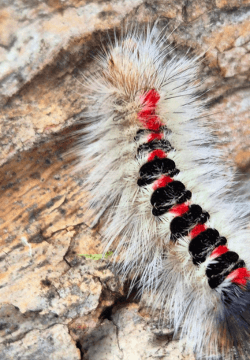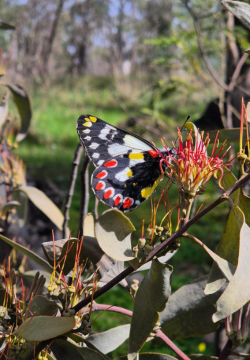 Long-tailed Bombyx (Trichiocercus sparshalli), photograph by Nayt Housman
Long-tailed Bombyx (Trichiocercus sparshalli), photograph by Nayt Housman
Take a walk on the Merri Creek this time of year and you’ll notice the changes that have guided generations of Wurundjeri Woi-wurrung people through the season of Porneet – tadpole season. During Porneet (normally observed in the months of August and September) Pied Currawongs can be heard calling, Grass Candles begin to respond to the warmer temperatures and longer daylight hours, and tadpoles begin to wriggle their tiny tails in their wetland homes.
The first thing that Merri Creek Management Committee’s Nayt Housman notices as Porneet approaches is the dragonflies darting among the grasslands. Nayt is a member of our “bush crew” or Ecological Restoration team, which spends its days caring for the landscapes that hug the banks of the Merri Creek and its tributaries. In rain, hail or shine, Nayt has observed the Merri’s plants and animals for four years, including two as a volunteer and the last eighteen months as a bush crew member.
“The invertebrates are the first to notice the early changes in season,” says Nayt. “You see lots of amazing caterpillars this time of year.”
Then there are the lizards that entertain Nayt as he goes about his work. “You start to see skinks moving about, just the little ones at first. Then we’ll usually start seeing some of the larger ones, like Cunningham Skinks, as the season progresses – I’m sure they’re aching to get out in the sun soon.”
In Porneet, Nayt loves observing the changing plumage of the male wrens and Red-browed Finches.
“The boys put on their spring clothes as breeding season goes into full swing,” he says. These spring clothes are part of the bird’s strategy to attract mates and are in contrast to the duller plumage of the previous season of Guling. This change in plumage is part of a regular molting cycle which also allows birds to regenerate damaged feathers and maintain efficient flight.
 Wood white or red-spotted Jezebel (Delias aganippe), photograph by Nayt Housman
Wood white or red-spotted Jezebel (Delias aganippe), photograph by Nayt Housman
Migratory birds like Sacred Kingfishers, Rufous Songlarks and White-winged Trillers return south for the breeding season too.
Nayt sees a flurry of seasonal activity in the vegetation that provides shelter for these woodland birds along the Merri.
“It’s all happening!” he says. “Clematis season has just finished so they're going to seed, with lovely, big, fluffy seed pods. Early-flowering acacias are finishing up and the golden season is beginning. We’ve seen our first Chocolate Lilies by early September – and Geraniums, the unsung heroes of the grasslands, are starting. Silver Wattles have finished flowering and smaller wattles are just beginning.”
Nayt’s ears are also open to the sounds of Porneet, as Eastern Froglets (“the cutest, weeniest of all the froglets”) can be heard croaking away along drainage lines as a sign of breeding. Despite being about the size of a pinky fingernail, adult Eastern Froglets make a “ratcheting” call that is surprisingly loud.
Nayt’s team also have their ears open for the call of the nationally vulnerable Growling Grass Frog, a species which supporters like you rallied behind during our recent campaign. Some of the work that Nayt and his team will be doing in the Moomba Park Wetlands during Porneet was made possible thanks to the support of people like you.
The observations Nayt has enjoyed along the creek are a fitting reward for the physical exertion he and his team contribute to its health. Porneet brings a flurry of activity as bush crew members remove a warm layer or two after their early, still-cool morning starts. Spraying of invasive weeds like Cape Tulip must happen while they are in flower and before they die back in November. Other weeds, like Serrated Tussock, are sprayed or chipped in Porneet before they have the chance to flower when the next season of Buath Garru begins. Left unmanaged, these invasive weeds could otherwise stifle growth of native species like Kangaroo Grass, Matted Flax-lily and Blue Devils.
“We’re also very aware that the days for planting are coming to an end,” says Nayt. “The last of the plants have to go in before the ground starts to dry up as rainfall reduces. We know the land is going to start drying out now – and these days, that drying-out is happening earlier.”
Nayt and his bush team crew members return to their Brunswick base in the mid-afternoon during Porneet season with weary bodies but hearts warmed by the gentle Spring sun.
“I love my job,” says Nayt with an infectious smile.





 Merri Creek Management Committee. 2 Lee St, East Brunswick, Victoria, Australia 3057
Merri Creek Management Committee. 2 Lee St, East Brunswick, Victoria, Australia 3057